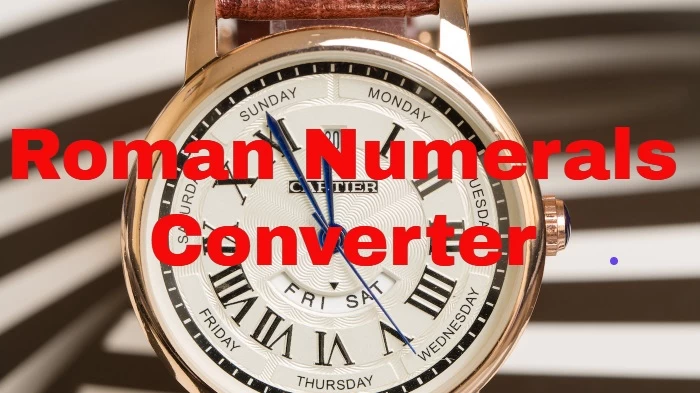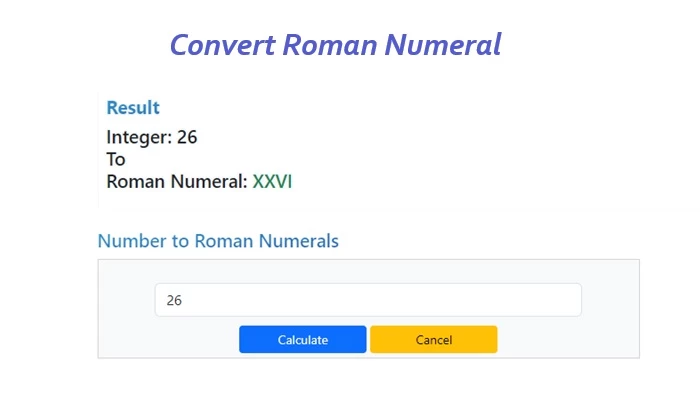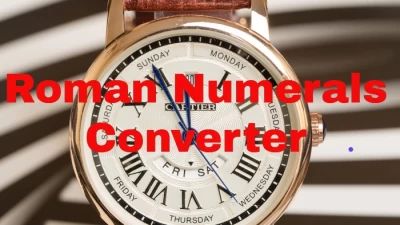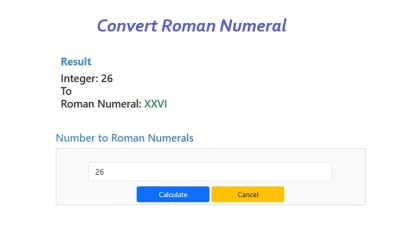Master Roman Numerals - From Royal Names to Hand Signals
Uncover the secrets of Roman numerals and learn easy mnemonic techniques and essential rules for formation. Become a Roman numeral pro.

Roman Numerals
Roman numerals are a system of numerical notation that originated in ancient Rome. Instead of using the familiar Arabic numerals (1, 2, 3, etc.), the Romans used a combination of letters from their alphabet to represent numbers. There are many fields where we use Roman numerals; sometimes, people immediately shift their calculations from standard numbers to Romans, so we offer an online free Roman numeral converter to assist you in your time of need. Along with all that, we also provide many other converters, like shoe size converters, area converters, volume converters, and weight converters, so you can have a number of particular units according to your wishes and needs with a single click.
Role of Roman Numerals in Royal Naming
Have you ever wondered about the significance of Roman numerals in the names of monarchs like Queen Elizabeth II, Henry VIII, and Pope Benedict XVI? It's not just a matter of tradition or a majestic appearance; there's a practical reason behind it. The use of Roman Numerals helps in retrospectively identifying sovereigns with the same name within a particular territory.
These numerals serve as regional numbers, essentially ordinal numbers, placed after the monarch's name to distinguish them from predecessors who share the same name. For example, when we say Queen Elizabeth II, it's pronounced as "Queen Elizabeth the Second". For Henry VIII, it's "Henry the eighth". This system makes it easier to differentiate between rulers with identical names, providing a practical and historical means of clarity. So, the use of Roman numerals in royal words is more about functionality than mere tradition.
How Do You Easily Remember Roman Numerals?
Roman Numerals may seem a bit tricky at first, but once you get the hang of them, they're not too hard. The challenge is remembering the symbols and what they stand for. Since we use Roman Numerals only a few times a week, it can be challenging to recall them on the spot. So, how can we make it easier? Here's a simple tip to start with - The Romans used only seven symbols for their numbers. You need to remember these seven letters and their values.
- I stands for 1
- V stands for 5
- X stands for 10
- L stands for 50
- C stands for 100
- D stands for 500
- M stands for 1000
Now, let's talk about the Hand Signals Theory. This theory makes it super easy to remember Roman Numerals from 1 (I) to 10 (X). It suggests that the Romans based their symbols on hand signals used for counting.
For 1 (I), 2 (II), and 3 (III), imagine counting on your fingers. For 5 (V), picture the hand signal when you show all five fingers by opening one hand. Moving on to 6 (VI), 7 (VII), and 8 (VIII), think of one hand showing 5 (V) and the other hand showing the additional numbers. Finally, for 10 (X), envision two hands showing two fives (V's) with thumbs crossed, forming the shape 'X'. This hand-counting theory is constructive for kids, making it a fun and simple way to understand Roman Numerals.

Rules for the Formation of Roman Numerals
Repetition Means Addition
When you see Roman Numerals with repeated symbols, you add their values. For example.
I = 1
II = 1 + 1 = 2
III = 1 + 1 + 1 = 3
X = 10
XX = 10 + 10 = 20
XXX = 10 + 10 + 10 = 30
Some Symbols Are Never Repeated
Symbols V, L, and D are never repeated. For instance, 'VV' is not used because it's the same as X (10).
When Should I Add?
If a smaller symbol is on the right of a larger one, you add their values. Examples are given below.
VI = 5 + 1 = 6
XI = 10 + 1 = 11
DLXII = 500 + 50 + 10 + 1 + 1 = 562
When Should I Subtract?
If a smaller symbol is on the left of a larger one, you subtract. For instance.
IV = 5 - 1 = 4
XC = 100 - 10 = 90
Don't Repeat More Than Three Times
Symbols can only be repeated up to three times in a row. For example, 4 is 'IV', not 'IIII', and 40 is 'XL', not 'XXXX'.
How to Write Really Large Numbers With Roman Numerals
For numbers greater than 1000, a bar is placed over the symbol to multiply its value by 1000. Examples are given below.
V¯ = 5 * 1000 = 5000
X¯X¯V¯ = 25 * 1000 = 25,000
M¯ = 1000 * 1000 = 1,000,000
How to Convert Roman Numerals to Decimals?
To convert Roman Numerals to decimals, group them into thousands, hundreds, tens, and ones, starting from the right. Determine whether to add or subtract. Examples are given below.
XXXVIII = 10 + 10 + 10 + 5 + 1 + 1 + 1 = 38
CXLII = 100 + 40 + 2 = 142
MMCMXCIX = 2000 + 900 + 90 + 9 = 2,999.
CoolCalculator offers a selection of calculators for different purposes; explore the website to find the ones that suit your needs.

Roman Numerals
Roman numerals are a system of numerical notation that originated in ancient Rome. Instead of using the familiar Arabic numerals (1, 2, 3, etc.), the Romans used a combination of letters from their alphabet to represent numbers. There are many fields where we use Roman numerals; sometimes, people immediately shift their calculations from standard numbers to Romans, so we offer an online free Roman numeral converter to assist you in your time of need. Along with all that, we also provide many other converters, like shoe size converters, area converters, volume converters, and weight converters, so you can have a number of particular units according to your wishes and needs with a single click.
Role of Roman Numerals in Royal Naming
Have you ever wondered about the significance of Roman numerals in the names of monarchs like Queen Elizabeth II, Henry VIII, and Pope Benedict XVI? It's not just a matter of tradition or a majestic appearance; there's a practical reason behind it. The use of Roman Numerals helps in retrospectively identifying sovereigns with the same name within a particular territory.
These numerals serve as regional numbers, essentially ordinal numbers, placed after the monarch's name to distinguish them from predecessors who share the same name. For example, when we say Queen Elizabeth II, it's pronounced as "Queen Elizabeth the Second". For Henry VIII, it's "Henry the eighth". This system makes it easier to differentiate between rulers with identical names, providing a practical and historical means of clarity. So, the use of Roman numerals in royal words is more about functionality than mere tradition.
How Do You Easily Remember Roman Numerals?
Roman Numerals may seem a bit tricky at first, but once you get the hang of them, they're not too hard. The challenge is remembering the symbols and what they stand for. Since we use Roman Numerals only a few times a week, it can be challenging to recall them on the spot. So, how can we make it easier? Here's a simple tip to start with - The Romans used only seven symbols for their numbers. You need to remember these seven letters and their values.
- I stands for 1
- V stands for 5
- X stands for 10
- L stands for 50
- C stands for 100
- D stands for 500
- M stands for 1000
Now, let's talk about the Hand Signals Theory. This theory makes it super easy to remember Roman Numerals from 1 (I) to 10 (X). It suggests that the Romans based their symbols on hand signals used for counting.
For 1 (I), 2 (II), and 3 (III), imagine counting on your fingers. For 5 (V), picture the hand signal when you show all five fingers by opening one hand. Moving on to 6 (VI), 7 (VII), and 8 (VIII), think of one hand showing 5 (V) and the other hand showing the additional numbers. Finally, for 10 (X), envision two hands showing two fives (V's) with thumbs crossed, forming the shape 'X'. This hand-counting theory is constructive for kids, making it a fun and simple way to understand Roman Numerals.

Rules for the Formation of Roman Numerals
Repetition Means Addition
When you see Roman Numerals with repeated symbols, you add their values. For example.
I = 1
II = 1 + 1 = 2
III = 1 + 1 + 1 = 3
X = 10
XX = 10 + 10 = 20
XXX = 10 + 10 + 10 = 30
Some Symbols Are Never Repeated
Symbols V, L, and D are never repeated. For instance, 'VV' is not used because it's the same as X (10).
When Should I Add?
If a smaller symbol is on the right of a larger one, you add their values. Examples are given below.
VI = 5 + 1 = 6
XI = 10 + 1 = 11
DLXII = 500 + 50 + 10 + 1 + 1 = 562
When Should I Subtract?
If a smaller symbol is on the left of a larger one, you subtract. For instance.
IV = 5 - 1 = 4
XC = 100 - 10 = 90
Don't Repeat More Than Three Times
Symbols can only be repeated up to three times in a row. For example, 4 is 'IV', not 'IIII', and 40 is 'XL', not 'XXXX'.
How to Write Really Large Numbers With Roman Numerals
For numbers greater than 1000, a bar is placed over the symbol to multiply its value by 1000. Examples are given below.
V¯ = 5 * 1000 = 5000
X¯X¯V¯ = 25 * 1000 = 25,000
M¯ = 1000 * 1000 = 1,000,000
How to Convert Roman Numerals to Decimals?
To convert Roman Numerals to decimals, group them into thousands, hundreds, tens, and ones, starting from the right. Determine whether to add or subtract. Examples are given below.
XXXVIII = 10 + 10 + 10 + 5 + 1 + 1 + 1 = 38
CXLII = 100 + 40 + 2 = 142
MMCMXCIX = 2000 + 900 + 90 + 9 = 2,999.
CoolCalculator offers a selection of calculators for different purposes; explore the website to find the ones that suit your needs.
Conversation
Latest Blogs
© Blog CoolCalculator, Explore CoolCalculator, your destination for the latest insights, tips, and updates on the world of online calculators. Stay informed and make your calculations smarter with our blog. ,
Designed
by Saad Media Team , Team Lead M.Rizwan Akhtar












